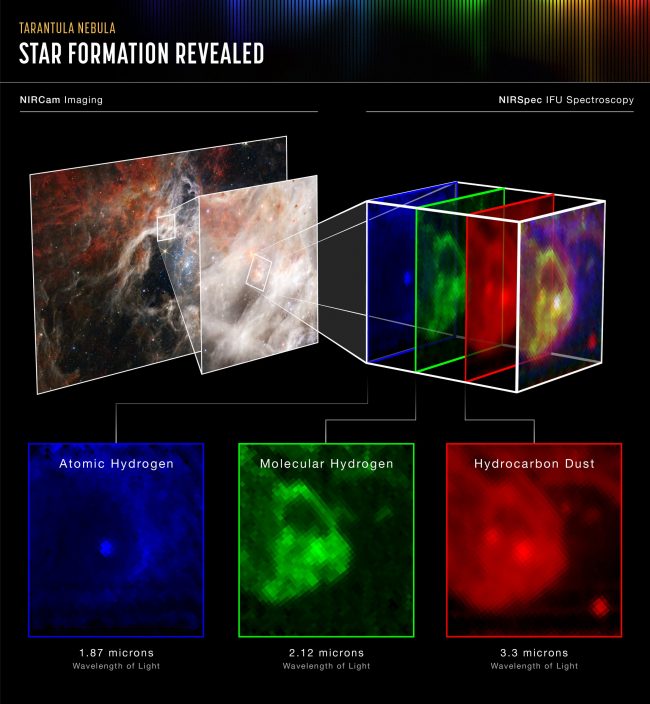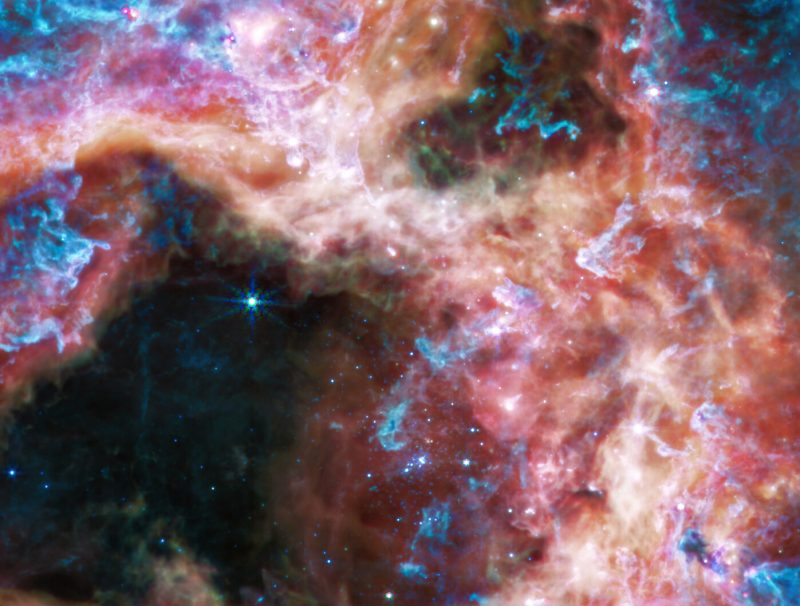
Webb catches the Tarantula Nebula
The Webb has caught a glorious image of the Tarantula Nebula. On September 6, 2022, NASA and ESA released new images of the Tarantula Nebula, also known as 30 Doradus, and its star-forming region. The James Webb Space Telescope has turned three of its instruments, NIRCam, NIRSpec and MIRI, on this cloudy and starry region that lies in the Large Magellanic Cloud, a satellite galaxy of the Milky Way.
In the new images, we can see sparkling star-forming regions that were previously hidden behind dust. And the gas and dust tendrils show different structure in the near-infrared of NIRCam and the mid-infrared of MIRI. Plus, we can even see distant background galaxies.
The Tarantula Nebula
The Tarantula Nebula lies 161,000 light-years distant in the LMC, which is in the Southern Hemisphere constellation of Dorado the Goldfish. In fact, this cloudy, dusty stellar nursery is home to the hottest, most massive stars known. By the way, the Tarantula Nebula is not only home to the largest and brightest star-forming region in the Large Magellanic Cloud but also in the Local Group, our regional collection of galaxies.
NIRCam’s view of the Tarantula
The image at the top of this article is NIRCam’s near-infrared view of the Tarantula. The hollowed-out region at center shows where fierce radiation from young stars have cleared the area. As well as massive, young stars sparkling in pale blue. ESA said:
Only the densest surrounding areas of the nebula resist erosion by these stars’ powerful stellar winds, forming pillars that appear to point back toward the cluster. These pillars contain forming protostars, which will eventually emerge from their dusty cocoons and take their turn shaping the nebula.
NIRSpec’s view of the Tarantula
NIRSpec is Webb’s Near InfraRed Spectrograph. And the spectrograph spreads light into a spectrum, which allows astronomers to investigate the object’s temperature, mass and chemical composition, for example. So, the young star NIRSpec focused on in the Tarantula Nebula is not yet at the stage where it’s clearing out the space around itself.

MIRI’s view of the Tarantula
The longer infrared wavelengths that MIRI sees let us look deeper into the Tarantula Nebula. So now we can see cooler areas, where protostars are still gaining mass.

Why Webb targeted the Tarantula Nebula
The Tarantula Nebula not only tells us about a massive star-forming region in the nearby universe, but it’s also an example of what was happening during the universe’ cosmic noon. Because this was a time when our universe was a few billion years old and star formation peaked. Besides, our Milky Way doesn’t have a comparable region of furious star formation.
Eventually, astronomers will be able to compare Webb’s images of the Tarantula Nebula with images of star-forming regions it sees in the earlier universe.
Two space telescopes, twice the star power.
This #TransformationalTuesday, watch as @NASAHubble’s view of the Tarantula Nebula fades into Webb’s NIRCam, then MIRI instrument views. Hubble and Webb will work together to showcase the universe across multiple wavelengths of light. pic.twitter.com/GDIRSWWFQV
— NASA Webb Telescope (@NASAWebb) September 6, 2022
Bottom line: The James Webb Space Telescope has captured images of the Tarantula Nebula, revealing stellar nurseries and protostars. This star-forming region lies in the Large Magellanic Cloud, a satellite galaxy of the Milky Way.
The post Tarantula Nebula and its baby stars sparkles in new Webb image first appeared on EarthSky.
0 Commentaires